The Bulldozer Review: AMD FX-8150 Tested
by Anand Lal Shimpi on October 12, 2011 1:27 AM ESTPower Management and Real Turbo Core
Like Llano, Bulldozer incorporates significant clock and power gating throughout its design. Power gating allows individual idle cores to be almost completely powered down, opening up headroom for active cores to be throttled up above and beyond their base operating frequency. Intel's calls this dynamic clock speed adjustment Turbo Boost, while AMD refers to it as Turbo Core.
The Phenom II X6 featured a rudimentary version of Turbo Core without any power gating. As a result, Turbo Core was hardly active in those processors and when it was on, it didn't stay active for very long at all.
Bulldozer's Turbo Core is far more robust. While it still uses Llano's digital estimation method of determining power consumption (e.g. the CPU knows ALU operation x consumes y-watts of power), the results should be far more tangible than what we've seen from any high-end AMD processor in the past.
Turbo Core's granularity hasn't changed with the move to Bulldozer however. If half (or fewer) of the processor cores are active, max turbo is allowed. If any more cores are active, a lower turbo frequency can be selected. Those are the only two frequencies available above the base frequency.
AMD doesn't currently have a Turbo Core monitoring utility so we turned to Core Temp to record CPU frequency while running various workloads to measure the impact of Turbo Core on Bulldozer compared to Phenom II X6 and Sandy Bridge.
First let's pick a heavily threaded workload: our x264 HD benchmark. Each run of our x264 test is composed of two passes: a lightly threaded first pass that analyzes the video, and a heavily threaded second pass that performs the actual encode. Our test runs four times before outputting a result. I measured the frequency of Core 0 over the duration of the test.
Let's start with the Phenom II X6 1100T. By default the 1100T should run at 3.3GHz, but with half or fewer cores enabled it can turbo up to 3.7GHz. If Turbo Core is able to work, I'd expect to see some jumps up to 3.7GHz during the lightly threaded passes of our x264 test:
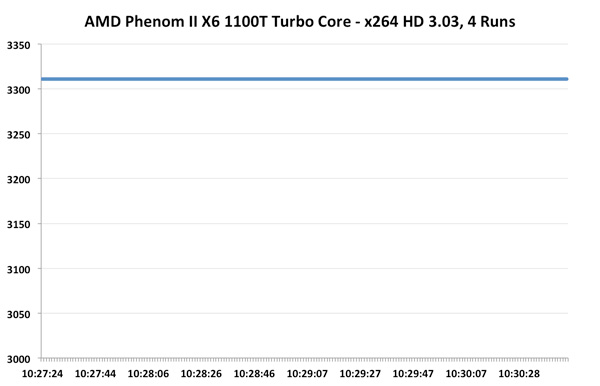
Unfortunately we see nothing of the sort. Turbo Core is pretty much non-functional on the Phenom II X6, at least running this workload. Average clock speed is a meager 3.31GHz, just barely above stock and likely only due to ASUS being aggressive with its clocking.
Now let's look at the FX-8150 with Turbo Core. The base clock here is 3.6GHz, max turbo is 4.2GHz and the intermediate turbo is 3.9GHz:
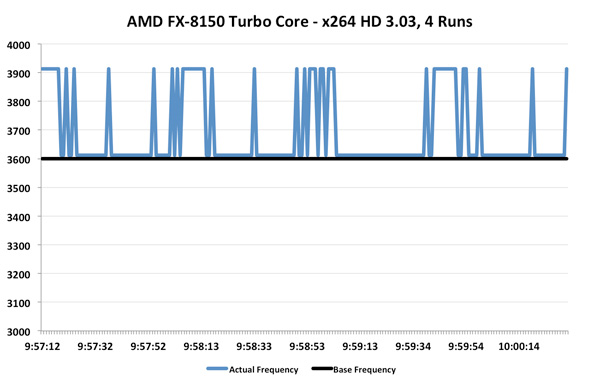
Ah that's more like it. While the average is only 3.69GHz (+2.5% over stock), we're actually seeing some movement here. This workload in particular is hard on any processor as you'll see from Intel's 2500K below:
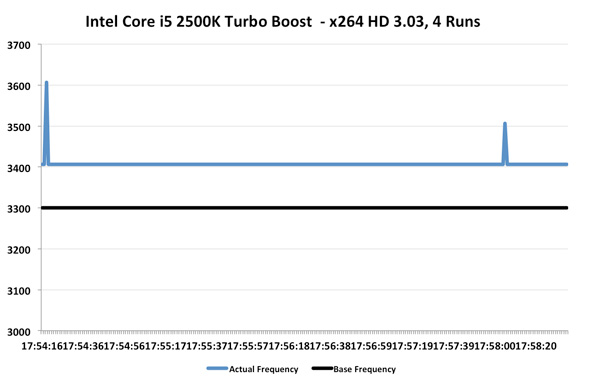
The 2500K runs at 3.3GHz by default, but thanks to turbo it averages 3.41GHz for the duration of this test. We even see a couple of jumps to 3.5 and 3.6GHz. Intel's turbo is a bit more consistent than AMD's, but average clock increase is quite similar at 3%.
Now let's look at the best case scenario for turbo: a heavy single threaded application. A single demanding application, even for a brief period of time, is really where these turbo modes can truly shine. Turbo helps launch applications quicker, make windows appear faster and make an easy time of churning through bursty workloads.
We turn to our usual favorite Cinebench 11.5, as it has an excellent single-threaded benchmark built in. Once again we start with the Phenom II X6 1100T:
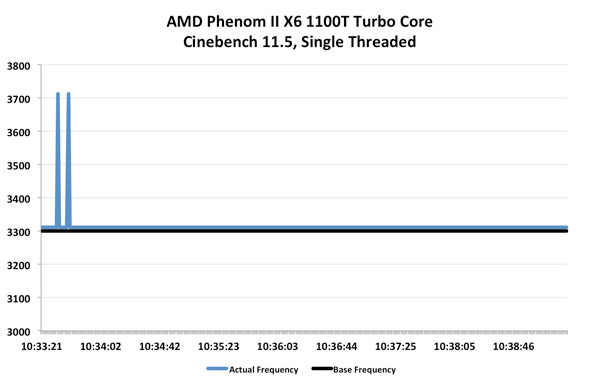
Turbo Core actually works on the Phenom II X6, albeit for a very short duration. We see a couple of blips up to 3.7GHz but the rest of the time the chip remains at 3.3GHz. Average clock speed is once again, 3.31GHz.
Bulldozer does far better:

Here we see blips up to 4.2GHz and pretty consistent performance at 3.9GHz, exactly what you'd expect. Average clock speed is 3.93GHz, a full 9% above the 3.6GHz base clock of the FX-8150.

Intel's turbo fluctuates much more frequently here, moving between 3.4GHz and 3.6GHz as it runs into TDP limits. The average clock speed remains at 3.5GHz, or a 6% increase over the base. For the first time ever, AMD actually does a better job at scaling frequency via turbo than Intel. While I would like to see more granular turbo options, it's clear that Turbo Core is a real feature in Bulldozer and not the half-hearted attempt we got with Phenom II X6. I measured the performance gains due to Turbo Core across a number of our benchmarks:

Average performance increased by just under 5% across our tests. It's nothing earth shattering, but it's a start. Don't forget how unassuming the first implementations of Turbo Boost were on Intel architectures. I do hope with future generations we may see even more significant gains from Turbo Core on Bulldozer derivatives.
Independent Clock Frequencies
When AMD introduced the original Phenom processor it promised more energy efficient execution by being able to clock each core independently. You could have a heavy workload running on Core 0 at 2.6GHz, while Core 3 ran a lighter thread at 1.6GHz. In practice, we felt Phenom's asynchronous clocking was a burden as the CPU/OS scheduler combination would sometimes take too long to ramp up a core to a higher frequency when needed. The result, at least back then, was that you'd get significantly lower performance in these workloads that shuffled threads from one core to the next. The problem was so bad that AMD abandoned asynchronous clocking altogether in Phenom II.
The feature is back in Bulldozer, and this time AMD believes it will be problem free. The first major change is with Windows 7, core parking should keep some threads from haphazardly dancing around all available cores. The second change is that Bulldozer can ramp frequencies up and down much quicker than the original Phenom ever could. Chalk that up to a side benefit of Turbo Core being a major part of the architecture this time around.
Asynchronous clocking in Bulldozer hasn't proven to be a burden in any of our tests thus far, however I'm reluctant to embrace it as an advantage just yet. At least not until we've had some more experience with the feature under our belts.


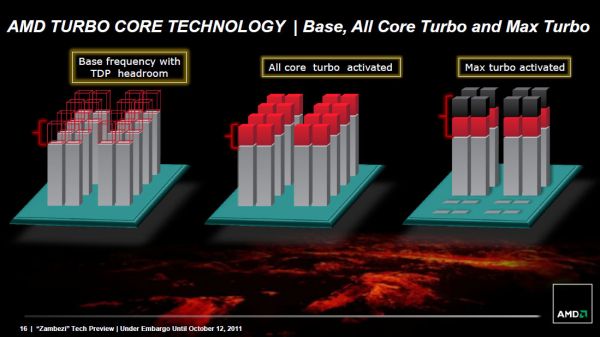








430 Comments
View All Comments
Pipperox - Saturday, October 15, 2011 - link
With a 40-50% gain Bulldozer would be even ahead of Ivy Bridge.. and what comes next.Or are we still talking about SuperPI?
Or games run at 640x480 lowest quality settings?
The fact is, almost all single threaded applications are old and they run already super fast on ANY cpu and the difference can be seen only in benchmarks.
All recent performance demanding applications are properly multithreaded, and Bulldozer there is competitive with i5 2500 and occasionally with i7 2600 (and with a 10% boost Bulldozer would be competitive with i7 2600).
And this will become more and more the standard one year from now.
Sure Bulldozer has not met the enthusiasts' expectations, it doesn't perform as people would expect an "octacore" (but it's not, it's just a quad with a different form of hyperthreading and "clever" marketing) and it doesn't deserve the FX moniker.
But still it's the most competitive CPU AMD has launched in years, perhaps with the exception of Zacate.
nirmv - Saturday, October 15, 2011 - link
Not all applications are heaviliy multi-threaded, there is still need to improve single thread performance.And even for those few loads that are competitive in performance, they do it with twice the power draw.
See here from xbitlabs review :
http://www.xbitlabs.com/images/cpu/amd-fx-8150/pow...
Pipperox - Sunday, October 16, 2011 - link
But increasing single threaded performance has a cost, on die space and circuit complexity.Bulldozer has a huge die just because it has enormous caches (8MB L2 vs 1Mb on SandyBridge) which probably will turn useful on server workloads (but that's just a guess).
By looking at the die shot, you'd get a 40% die area reduction with "normal" caches.
So AMD engineers decided to drop single threaded performance improvements in favor of higher multithreaded scalability and higher clock speed scalability.
We'll see if in the long run this will pay off.
I agree power consumption doesn't look good in comparison with Intel, but it does look good in comparison to Thuban.
This is the first released silicon of Bulldozer.. i expect power consumption to improve with newer steppings and silicon process tuning.
That being said, Intel has the best silicon process in the whole industry.
AMD can't compete with that.
But i'd guess that at lower clock speeds (like in server), AMD's power consumption will improve a lot.
Looks like with the FX AMD tried to push their current silicon to the maximum which they could (within the 125W TDP which is sort of an industry standard).
LiveandEnjoyLife - Friday, October 14, 2011 - link
Some people are missing the point. At this stage in the game, processor speed is a moot point beyond benchmarks. AMD and Intel make very fast CPUs in relation to what gamers and every day users use them for. Intel CPUs are blazing fast and AMD CPUs are fast. The average Joe does need more than a dual-core CPU. If you were going to actually do something that would require heavy multi-threading, then it comes down to the efficiency the app to make use of the cores and the ability to use hyperthreading. If you wanted the most performance for a mult-threaded application, you would pick more physical cores over virtual cores. So for most of use it comes down to bang for buck.8 cores is better than 2, 4, or 6 for true multi-threaded capable applications.
For speed tests Intel wins hands down.
If you were sitting next to someone playing a game and all things were the same except CPU, you would not be able to tell which machine is running what CPU. However you would notice if one costs significantly more than the other.
That is my 4 cents.
7Enigma - Friday, October 14, 2011 - link
Hi Anand,Great review but there is a text error when referring to pass one vs. pass two of the benchmark mentioned in the Subject line. You said:
"The standings don't change too much in the second pass, the frame rates are simply higher across the board. The FX-8150 is an x86 transcoding beast though, roughly equalling Intel's Core i7 2600K. Although not depicted here, the performance using the AMD XOP codepath was virtually identical to the AVX results."
But the graph clearly shows a complete flip-flop from first pass to second pass. When I look closely it appears you ordered the text and graphs differently and were referring to if you had the non-AVX and AVX-enabled graphs next to each other instead of in separate sections. Basically the text and graphs don't match up.
HTH
Iketh - Friday, October 14, 2011 - link
You're an utter retard. The reason they're sold out is newegg advertised these nicely all over their site, including the front page, with "World's first 8-core desktop processor."There are plenty of reasons to purchase these processors aside from their performance and that's ok. But the majority bought them thinking they're gonna "rock", and those are the ones "showing intelligence." Same goes to you for thinking the majority is well-informed/intelligent.
What's even worse, the 8-core version for sale is the 3.1ghz, not the 3.6 tested in this review. I'm seriously LOL'ing...
How many did Newegg have in stock anyhow? Wouldn't that figure matter regarding your ignorant comment?
rcrossw - Friday, October 14, 2011 - link
I have used AMD products for years. I use Intel at work. So to me there is no real difference between the two for what Business and the Average Computer user want or expect.Does it run, does it do the work I require of it, and do my programs and Network Access
work well and are reliable?
Intel indeed has incredible Processors, fast and reliable, and in the high end - expensive.
AMD is Low and Mid range - with processors that the average person can afford. Who is the most innovative - both. Today Intel has been , now I think the user needs to give this New X86-64 Architecture a chance.
I have a Asus M5A99x EVO with an FX6100 installed. The only problem I have had is having to upgrade the BIOS to accept the new Processor. So far I have had the Processor to 4.2 Ghz. Though AIDA 64 caused a BOD on one test. At 3.8 Ghz runs like a champ. Stil
working back to as close as I can get to 4.2 on Air.
After three years I have retired my old Phenon II Tri Core 720 for this, and it works for me.
I am not an extreme gamer, etc. But test it your self, before being too overly critical.
Does it work for me.
As an aside, next a SSD for faster response.
For those interested:
Asus M5A99x MB BIOS 0810 ( Newest)
AMD FX 6100 at 3.8 ghz
Corsair Vengeance 1600 - 16 gigs
HIS Radeon HD 6850
Windows 7 Ulimate 64
HPLP2475W Monitor at 1920x1200 DP
WD 500 SATA
WD 1001 SATA
LG H20L BD-R
Plextor DVDR
Enermax 620 Liberty PS - I know old but works.
Thanks
davbran - Saturday, October 15, 2011 - link
I have been having a hard time writing a comment on this topic without drawing fire from trolls.This review is hogwash without more information.
If the hardware is the same on all test machines, apart from the CPUs, then there is no wonder the performance was so bad. 6 Cores are going to utilize, and I am just pulling a number out of my ... hat, 4gb of RAM more efficiently than an 8 core using simple kitchen math. No need to break out the slide rules. It's a known fact, to most, that the big bottleneck in the multicore/multiprocessor world is memory. Mind you that's if we are factoring in that all the code that was used for testing purposes was written with multi-threading in mind.
You just can't compare apples to bananas in this manner.
silverblue - Saturday, October 15, 2011 - link
Each to their own. I thought it was a pretty good review, and Anand certainly held back from slating AMD to hell.Iketh - Sunday, October 16, 2011 - link
LOLLLLL